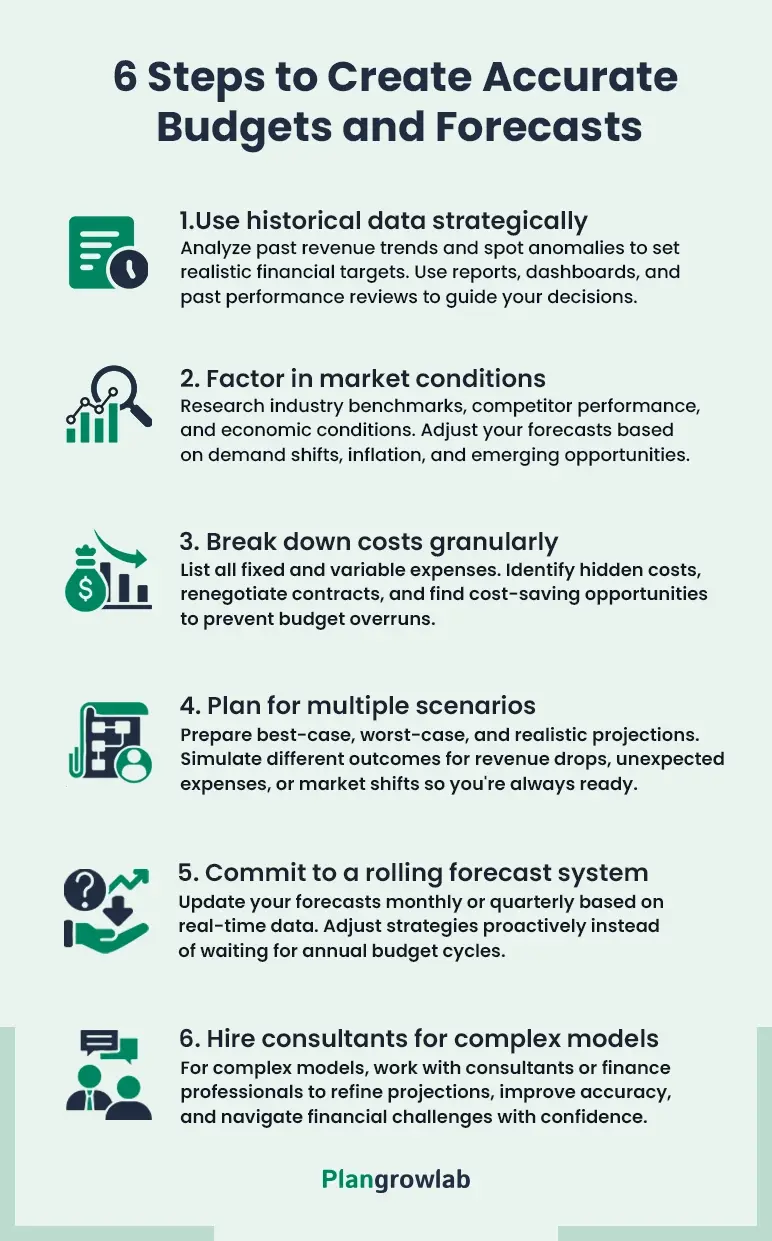Entrepreneurs often find themselves in a tricky spot. You set clear targets at the beginning of the year but by mid-year—things start to look wildly different.
The revenue isn’t where you thought it would be, expenses creep up and suddenly, your plan feels more like a wish list. The root of the problem often lies in the mix-up between budgeting and forecasting.
While a budget is your plan for the year ahead, a forecast helps you see whether or not your business is capable of achieving the plan. Getting the budget vs forecasts comparison right can make all the difference—and that’s what we will help you understand today in this article.
So, let’s get started.
What is a budget?
A budget is a financial plan that outlines expected revenue, expenses, and cash flow over a set period, usually a fiscal year. It helps to set clear goals and serves as the baseline to measure your business’s performance by comparing the projected revenue targets with the actual results.
- A business’s budget usually includes:
- Revenue estimates
- Expected debt reduction
- Expected cash flows
- Fixed costs
- Variable costs
- One-time expenses
- Profits
What is a financial forecast?
A financial forecast estimates a company’s financial future outcomes for one fiscal year or more by examining the business’s historical data and past trends. This educated guess helps entrepreneurs predict future revenues, expenses, and cash flow to guide strategic decision-making.
Unlike budgeting, financial forecasting goes beyond business operations and takes macroeconomic factors into account—such as social and political factors that might affect market trends.
A business’s financial forecasting usually includes:
- Cash flow statement
- Income statement
- Balance sheet
Now that you have an idea about budgeting and financial forecasting, let’s move on to identifying the difference between budget and forecast.
Key differences between budgeting and financial forecasting
Here’s a table showing the difference between budget and forecast for you to understand its impact on your business.
| Budgeting | Financial Forecasting | |
|---|---|---|
| Purpose | Allocates resources, controls performance, and tracks business performance against predefined targets. | Aims to predict future financial outcomes and guide strategic planning and decisions based on market conditions. |
| Time-frame | Covers a fixed period, typically of one fiscal year, and remains relatively static. | Provides a continuous financial outlook, typically covering one to five years—to reflect changing conditions. |
| Details | Highly detailed and breaks down the revenue and expense line items into precise categories to set spending limits. | Provides broader estimates of expected revenues, expenses, and cash flow without as much granularity. |
| Focus | Prioritizes maintaining control over finances while working toward a specific company’s financial goals. | Predicts the future financial performance and business conditions to assess the feasibility of meeting goals. |
| Review Frequency | Reviews periodically, often quarterly or annually to track against fixed targets. | Updated regularly—typically monthly or quarterly—to reflect market conditions, unexpected expenses, and revenue fluctuations. |
We hope the table above has helped you understand the differences between budget and forecast. Now, let’s check out some for a better understanding.
Budgeting vs forecasting example
Check out the example below to understand the clear difference between budget and forecast.
Budget example
Let’s say a retail company generated $39,433 in revenue last year. For the upcoming year, the company’s budget includes a goal to increase expected revenues by 4%, targeting $41,010.32.
| Category | Previous year actual | Current year projected | Current year actual |
|---|---|---|---|
| Revenue Total | $39,433.00 | $41,010.32 | To be reviewed |
| Product Sales | $26,288.67 | $27,340.21 | To be reviewed |
| Service Income | $10,515.47 | $10,936.09 | To be reviewed |
| Other Income | $2,628.87 | $2,734.02 | To be reviewed |
| Operating Expenses Total | $24,711.35 | $25,699.80 | To be reviewed |
| Salaries and Wages | $10,515.47 | $10,936.09 | To be reviewed |
| Rent and Utilities | $4,206.19 | $4,374.43 | To be reviewed |
| Marketing and Advertising | $2,628.87 | $2,734.02 | To be reviewed |
| Research and Development | $3,680.41 | $3,827.63 | To be reviewed |
| Miscellaneous | $2,628.87 | $2,734.02 | To be reviewed |
| Operating Income | $14,721.65 | $15,310.52 | To be reviewed |
The company plans the expected revenues to come from $27,340.21 in product sales, $10,936.09 from service income, and $2,734.02 from other income sources. To support this growth, the company’s operating expenses, which totaled $24,711.35 last year, are about to rise slightly to $25,699.80—due to higher budget projections on salaries, utilities, and marketing.
Forecast example
After establishing a budget for the year, let’s say, the retail company wants to determine if it’s feasible to achieve its planned revenue target of $550,000. To understand this, the company needs to do financial forecasting by reviewing its historical data and growth patterns.
Here’s an example:
The company generated $39,433 in January and aims to increase it using a 3% average monthly growth rate based on previous cycles. Assuming this trend continues, here’s how the projected revenue for the next year would look:
| No. of months | Month | Projected Revenue |
|---|---|---|
| 1 | January | $39,433.00 |
| 2 | February | $40,615.99 |
| 3 | March | $41,834.47 |
| 4 | April | $43,089.50 |
| 5 | May | $44,382.19 |
| 6 | June | $45,713.65 |
| 7 | July | $47,085.06 |
| 8 | August | $48,497.62 |
| 9 | September | $49,952.54 |
| 10 | October | $51,451.12 |
| 11 | November | $52,994.65 |
| 12 | December | $54,584.49 |
| Total | $559,634.28 | |
How to create more accurate budgets and forecasts?
We’ve listed some tips from our consultants below to help you create accurate budgets and forecasts for your business.

1. Use historical data strategically
Use historical data to analyze revenue, expenses, and cash flow trends over multiple years to identify patterns and anomalies. You can also use advanced tools to differentiate between regular seasonal trends and one-off events to set appropriate financial goals.
2. Factor in market conditions
Go beyond internal data and integrate market research and industry trends in your financial planning. Include competitor benchmarks, inflation rates, and anticipated market trends as well for estimating future business performance accurately.
3. Break down costs granularly
Take a granular approach while assessing the costs to ensure no line items are overlooked. Identify the fixed costs like leases and salaries that remain constant and variable costs like production or marketing that fluctuate with revenue.
4. Plan for multiple scenarios
Avoid a one-size-fits-all approach by creating multiple financial scenarios—best-case, worst-case, and baseline. This scenario planning allows you to anticipate changes earlier—be it a drop in sales or unplanned expense spikes due to external factors.
5. Commit to a rolling forecast system
Replace the static annual budgets with a rolling basis model that’s updated monthly or quarterly. This allows you to adapt to real-time performance and external factors and ensures your financial planning remains relevant.
6. Hire consultants for complex models
If you’re dealing with intricate financial structures or stepping into newer markets—it’s always a smart move to hire consultants and get an expert opinion. Financial consultants bring an unbiased perspective, provide industry-specific insights, and help refine your financial projection and planning.
Do you need a budget or a forecast?
Well, the answer isn’t about choosing one over the other—you need both budget and forecasts but at different stages of your business journey.
Each plays a distinct role in financial planning, and understanding how they work together helps you stay on track and make smarter decisions.
Many businesses are confused between both, but understanding the comparison is the key. Now, let’s do a budget vs forecast comparison to help you understand better.
A budget helps you set a detailed plan for your business’s revenue, expenses, and cash flow over a specific time period. So, if you want to focus on resource allocation, management, and setting reliable financial goals—a budget is essential.
Let’s say, you’re launching a new product—you need to create budgets to allocate resources and align spending requirements for marketing, distribution, and promotion.
On the other hand, financial forecasting helps you predict your business’s future financial direction—based on past data, current business performance, and external factors like market trends. If your priority is to identify risks and anticipate changes, you can go for forecasting.
For example, if you’re planning to expand your business or make some new investments, financial forecasting can help you evaluate financial viability and adjust revenue and expense expectations dynamically.
Why do you need both?
Because a budget and forecast complement each other. A budget provides the foundation and structure for your financial planning, while a forecast ensures you can adapt to real-world changes and stay on course.
Let me give you an example. A manufacturing company has set a budget at the start of the year with a revenue target of $5M. Midway through the year—market conditions shift and demand for their product drops due to new competition.
However, by analyzing current sales trends and past data, the projections forecast the annual revenue to be $4.5M. This gives the company a chance to adjust its strategy and mitigate losses.
A way forward
Now that you understand the budget vs forecast comparison—you can see why both are essential for a business to run smoothly. While a budget helps you set a financial goal, a forecast keeps you agile to tackle the twists that come your way.
However, even with a solid understanding, execution can be a challenge. Forecasting, in particular, requires detailed analysis, industry insights, and ongoing updates to ensure accuracy in financial projections. This is where expert consultants can make a significant impact.
At Plangrowlab, our financial forecasting consultants bring expertise, fresh perspectives, and the right tools to create accurate, actionable forecasts that take the guesswork out of financial planning. Talk to our financial forecasting experts and start preparing for your business’s financial future today!
Frequently Asked Questions
Should you hire experts for budgeting and forecasting?
Hiring experts for budgeting and forecasting can be a smart move, especially if your financial planning feels overwhelming or complex. While you might handle basic plans on your own, experts bring specialized knowledge, tools, and experience to the table.
What is the difference between budget and forecast?
A budget is a fixed financial plan that sets goals for revenue, expenses, and cash flow over a specific period, while a forecast predicts future outcomes based on current data and trends.
Which comes first, budgeting or forecasting?
Forecasting typically comes first, as it uses current data and trends to predict future financial outcomes. These insights then help to create budgets. Forecasts, however, inform budgets and help to understand whether you’re on the course of achieving your financial goals.
Do small businesses need both a budget and a forecast?
Yes, small businesses need both a budget and a forecast. A budget helps set clear financial goals and manage resources effectively—while a forecast provides flexibility by predicting outcomes based on current trends.

